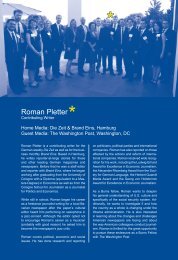Disaster and Crisis Coverage - International News Safety Institute
Disaster and Crisis Coverage - International News Safety Institute
Disaster and Crisis Coverage - International News Safety Institute
You also want an ePaper? Increase the reach of your titles
YUMPU automatically turns print PDFs into web optimized ePapers that Google loves.
<strong>Disaster</strong> <strong>and</strong> <strong>Crisis</strong> <strong>Coverage</strong><br />
Organize contact information<br />
Make sure the staff list is complete <strong>and</strong> current, both on computer <strong>and</strong> hard-copy.<br />
The list should note exactly where people live (a map can be helpful). Also<br />
include other critical information (has a 4-wheel-drive vehicle, is trained in first<br />
aid, is an amateur radio operator, etc.) Collect contact information for emergency<br />
response officials, major public institutions (including schools) <strong>and</strong> independent<br />
experts on disaster-related topics. Be sure to include both l<strong>and</strong> lines <strong>and</strong> cell<br />
phones. Consider creating a laminated card with key names <strong>and</strong> numbers for all<br />
staff members to keep with them at all times. This blank list may provide a useful<br />
template: http://www.rtnda.org/media/pdfs/education/fellowships/rias/crisis.pdf.<br />
Build relationships<br />
Connect with sources who can provide essential information during a disaster:<br />
emergency preparedness <strong>and</strong> law enforcement officials, military leaders, hospital<br />
workers, subject experts <strong>and</strong> relief organizations. (For a searchable list of<br />
international relief groups, see: http://www.alertnet.org/thepeople/<br />
whowhatwhere.htm.) Showing interest now, well in advance of any incident, will<br />
build relationships that can pay off when disaster strikes. Officials are more likely<br />
to grant access to disaster areas <strong>and</strong> return phone calls if they already know the<br />
journalists they are dealing with.<br />
Map the community<br />
Get up-to-date local maps to keep in the newsroom. In a crisis, having a few<br />
extra pocket maps can save a lot of time <strong>and</strong> effort. Don’t depend exclusively on<br />
GPS technology to help staffers get around; it could fail in a major emergency.<br />
Know the exact locations of potential terrorist targets, including government <strong>and</strong><br />
military buildings <strong>and</strong> places where large groups gather. Map all hospitals <strong>and</strong><br />
emergency clinics. Obtain maps <strong>and</strong> schematics of government buildings,<br />
transportation hubs, <strong>and</strong> any locations where hazardous materials are used.<br />
Survey likely scenarios<br />
Look back at disasters that have happened in the past to see what sort of<br />
damage was caused <strong>and</strong> how authorities <strong>and</strong> the newsroom responded. Collect<br />
background information <strong>and</strong> links to online databases <strong>and</strong> make it easily<br />
accessible to everyone in the newsroom. Ask experts to help assess the<br />
likelihood of future disasters. [link to “Preview of Destruction”] Meet with local<br />
disaster response officials to learn more about their plans for dealing with<br />
emergencies. If possible, participate in mock exercises.<br />
Educate the staff<br />
Consider sending reporters <strong>and</strong> editors to seminars to help them underst<strong>and</strong><br />
potential threats <strong>and</strong> scenarios, or bring experts into the newsroom to conduct<br />
lunch-time discussions on topics such as:<br />
13
















